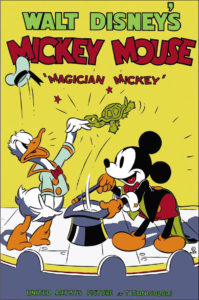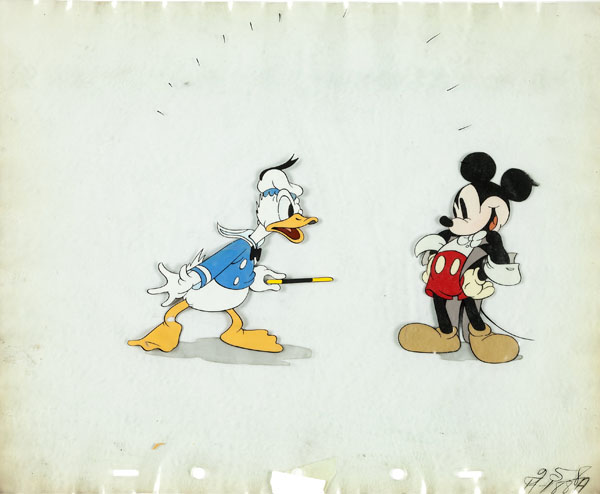
This week’s animator breakdown presents another Mickey Mouse cartoon I’ve been anxious to write about!
In March 1935, about a month after the release of Mickey’s first cartoon in Technicolor, The Band Concert, the Disney studio distributed an outline for a short tentatively titled Mickey’s Vaudeville Show. The original outline detailed a two-act structure set during a stage show, the first part being a magic act with Mickey as a magician, with Donald Duck as his assistant. The second half featured Donald and Clara Cluck in an operatic recital, with Pluto chasing a magician’s hat after he discovers rabbits and other creatures concealed inside. The two halves split into their own standalone films; the latter evolved into Mickey’s Grand Opera (1936). (The animator draft for Mickey’s Grand Opera can be seen here).
 Like The Band Concert, the first story outline for the first half of Mickey’s Vaudeville Show had Donald Duck act as an aggressor toward Mickey, for his own amusement. As Mickey performs his magic tricks, Donald continually sabotages them. By the end of the first half, Mickey’s frustration over his assistant’s skepticism leads him to use real magic, by having Donald pour out of an egg that appears in thin air. After noticing his fright, Mickey hypnotizes Donald, levitates him and drops him on the floor. The reworked story of the film, which became Magician Mickey, features a solo magic act with Donald as an off-stage heckler. In the original treatment, Goofy took part in Mickey’s act as a volunteer for one of his tricks—another exposed by Donald—but is given a different role as a stagehand in the reworked film.
Like The Band Concert, the first story outline for the first half of Mickey’s Vaudeville Show had Donald Duck act as an aggressor toward Mickey, for his own amusement. As Mickey performs his magic tricks, Donald continually sabotages them. By the end of the first half, Mickey’s frustration over his assistant’s skepticism leads him to use real magic, by having Donald pour out of an egg that appears in thin air. After noticing his fright, Mickey hypnotizes Donald, levitates him and drops him on the floor. The reworked story of the film, which became Magician Mickey, features a solo magic act with Donald as an off-stage heckler. In the original treatment, Goofy took part in Mickey’s act as a volunteer for one of his tricks—another exposed by Donald—but is given a different role as a stagehand in the reworked film.
Dave Hand (assisted by Jack Cutting) is the director of Magician Mickey, and his other Disney shorts, only a few animators are assigned to the film. Les Clark, Ed Love and Bill Roberts, in particular, have extended sequences throughout much of the cartoon. In some of his finest work for Disney, Clark is mostly assigned to scenes with Mickey, where he exhibits incredible magic tricks, such as tying and transfiguring his black cape into a crow, which flies away off stage. (The song accompanying these scenes is Paul Lincke’s waltz “Spring, Beautiful Spring.”)
Clark also handles Mickey’s nimble abilities in repelling Donald’s pesky behavior. When Donald upsets a card trick with the gust of a bellows, Mickey converts the fallen cards into a flock of small canaries. Further disbelief from Donald leads a crafty Mickey to perform his own card trick. With the command of his magic wand, Donald now becomes the victim of Mickey’s act, discharging an entire deck of cards from his mouth whenever he throws an angry tantrum, which occurs at least five times in the film. Clark’s scene of Donald being poured out of an egg and reconfigured in his solid form was one of the few elements kept from the original Vaudeville Show outline. Production papers suggest the three scenes credited to Riley Thomson were originally assigned to Clark, and that he supervised Thomson in animating the finished scenes.

In some of his early work as a full-fledged animator, after working under Ben Sharpsteen, Ed Love is credited on the scenes of Goofy operating the lights from above stage. One of Love’s scenes includes a brief interlude when a light bulb malfunctions, which Goofy fixes in the most appropriate fashion. Love animates a few scenes with Donald from the balcony and on stage, including a section where his damage to Mickey’s wand results in a cactus plant, with boxing gloves, pummeling him with several blows. Love continues the action behind the stage with Donald about to strike with a fire axe before being pelted by light bulbs from above.
Bill Roberts handles many of the scenes with Donald. He draws him with a noticeably smaller cranium than Ed Love. A former magazine illustrator in New York, Roberts started as a “junior” animator under Sharpsteen around 1932. He soon broke away from his apprenticeship by late 1933, developing a reputation for fast action in his work. As Shamus Culhane recalled about working with Roberts in his autobiography Talking Animals and Other People, Roberts would toil over his work as he puffed on his pipe. “He would grunt, swear, and stop for long periods looking moodily at his drawing…then, with a big sigh, he’d rip the drawing off the board, toss it into the wastebasket, and start again.”

Roberts is credited with the establishing scenes of Donald harassing Mickey, along with the sequence of Donald storming the stage to grab Mickey’s wand—thus allowing the personalities of the two characters to counteract in the second half of the film. The original intended gag from Vaudeville Show of rolling Donald into a wad and tossing him into the air is substituted for different alterations, as animated by Roberts. After Mickey shrinks Donald into multiple ducks, even displaying him as a paper doll chain, he shrinks Donald into the size of a bullet, which Mickey inserts into his pistol and fires into an egg, now set on a table instead of materializing suddenly, as the original outline dictated. Roberts also animates the sequence of Donald transformed into other animals as he passes through a hoop, after which he grabs the pistol and points it Mickey.
 Izzie Klein animates the final sequence of Magician Mickey, from Donald firing the flare gun up to the final close-up of Donald sputtering cards from his mouth, with a joker card the last to appear—a contribution of Klein’s. As Klein recalled to John Culhane in an interview, when director Dave Hand assigned him to the final shot in the film, they were both aware of the challenges due to the mass amount of playing cards. Klein stated, “There was a little smirk in the way he handed that scene to me. I could tell from his expression.” As a result, Klein drew three combinations of cards. He used the least amount of drawings in mathematical combinations, as he explained: “They [the combinations] were not of the same number, otherwise one combination might have been of seven drawings, and another would be an even number and another would be an odd number. So I kept on combining them.”
Izzie Klein animates the final sequence of Magician Mickey, from Donald firing the flare gun up to the final close-up of Donald sputtering cards from his mouth, with a joker card the last to appear—a contribution of Klein’s. As Klein recalled to John Culhane in an interview, when director Dave Hand assigned him to the final shot in the film, they were both aware of the challenges due to the mass amount of playing cards. Klein stated, “There was a little smirk in the way he handed that scene to me. I could tell from his expression.” As a result, Klein drew three combinations of cards. He used the least amount of drawings in mathematical combinations, as he explained: “They [the combinations] were not of the same number, otherwise one combination might have been of seven drawings, and another would be an even number and another would be an odd number. So I kept on combining them.”
With a musical score by former vaudeville and radio organist Albert Hay Malotte, Magician Mickey was released to theaters on February 6th, 1937—almost two years after the outline for Mickey’s Vaudeville Show was issued at the studio.
Enjoy!

(Thanks to J.B. Kaufman, Dave Gerstein and Didier Ghez for their help.)


 DEVON BAXTER is a film restoration artist, video editor, and animation researcher/writer currently residing in Pennsylvania. He also hosts a
DEVON BAXTER is a film restoration artist, video editor, and animation researcher/writer currently residing in Pennsylvania. He also hosts a 





















































































Hi Devon, why do you have a link to the draft to Mickey’s Grand Opera, when the subject of your post is Magician Mickey? Also, do you know who did the great fireworks fountain effects animation in the penultimate Klein scene? Thanks for your post today,
Mark
Hi Mark, I just wanted to show people that the draft for GRAND OPERA is available to see. I’m also aware the video isn’t working, so I’m getting right on that…
As for the fireworks fountain, I’m not quite sure, though it COULD be Dan MacManus’ work.
Whoa, Izzy Klein worked for Disney before heading to Famous Studios? Well, that’s fascinating.
Whose signatures are on the model sheet? I can read “D. D. H.” (David Dodd Hand), “Bill” (Roberts) and “Les” (Clark), but I can’t identify the other names.
There is a “G.S.” for George Stallings for the story credit. I didn’t mention it here, but surviving production records DO indicate that Stallings was the story director for this cartoon.
It’s “Babbitt”, not “Bill”. Presumably they were originally going to assign him to Goofy’s scenes.
I remember a LONG time ago as a kid when I watched this, a scene where Mickey makes Donald appear inside of a crystal ball instead of an egg, and I remember Donald BREAKING it to get out!!!! I have talked to a couple of other ppl who remember this as well…. Could that scene have existed in an earlier draft?